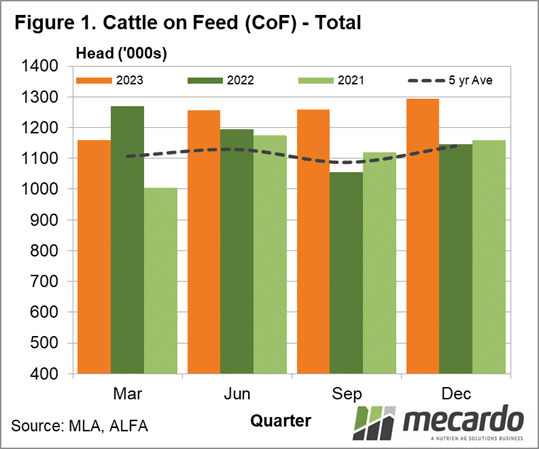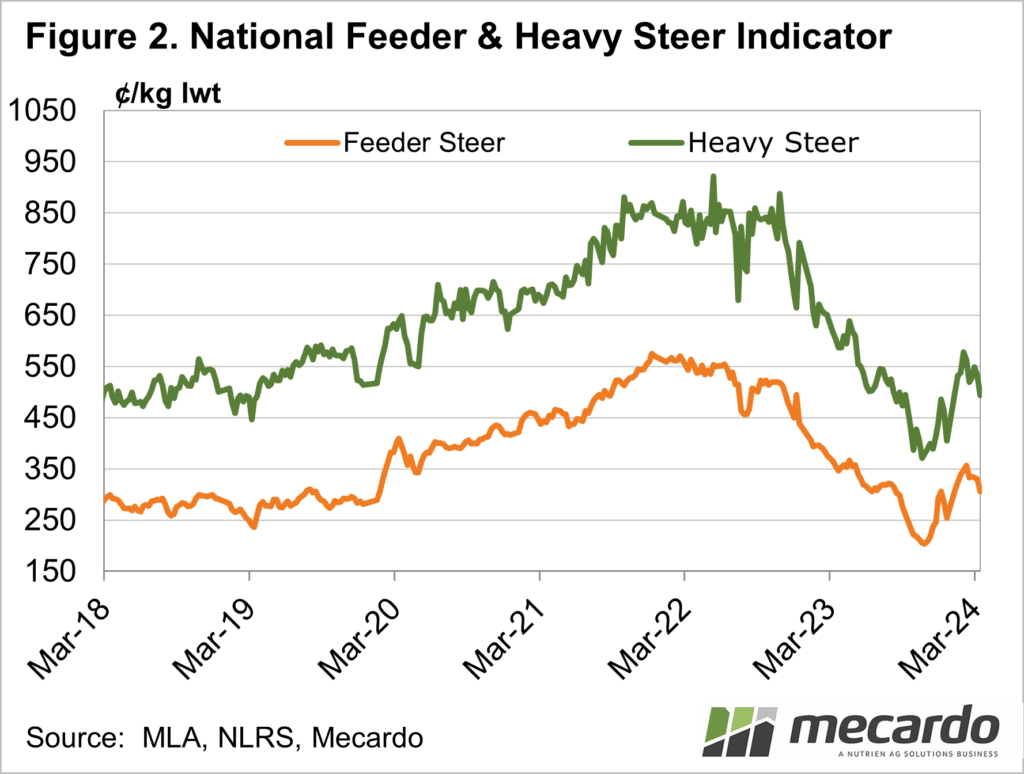Volatile market conditions for cattle didn’t scare the lot feeding sector into submission last year with yet more growth recorded for the final quarter. The number of cattle on feed in Australia grew by 2.9% in the September-December period, to a record high of 1.29 million head. The number of cattle able to be fed also grew (for the fifth quarter in a row) and grain-fed cattle turnoff took a jump up as well.
Looking at the state breakdown,
NSW and South Australia recorded their highest number of cattle on feed ever in
the December quarter, and utilisation (how much of the available lot feeding
space was used) grew in both states, up 15% to 80% in NSW, and up 11% to 90% in
SA – putting it at the most utilised. Cattle on feed numbers fell from the
previous quarter in Queensland but were 10% higher year-on-year, and Victoria
followed suit. Victorian had the equal lowest utilisation (on par with Western
Australia’s) at just 65%.
As we saw in the figures
from the September 2023 quarter, the number of cattle on feed can be boosted by
low turnoffs, rather than just high intakes. This wasn’t the case for December,
however, with grain-fed cattle turnoff rising by about 50,000 compared to both
the previous quarter, and the same quarter in 2022.
Grainfed export volumes
fell after setting a record in the July-September period but were still at
their second-highest level ever and rose 18% for the year. Japan remained the
largest grain-fed market, but took less product in 2023, while China increased
intake by 26% for the year, and South Korea by nearly 8%.
Capacity and utilisation
are also clear indicators of how the sector is faring. As mentioned above, the
number of cattle able to be fed across the country has risen every quarter
since mid-2022. It rose to a record 1.59 million head by the end of last year,
a 4% climb compared to the same quarter in 2022. Utilisation also increased to 81% in the
latest data, compared to just 75% 12 months earlier. From the annual
perspective though utilisation was similar in 2023 as it was in 2022.
Supporting more cattle
going onto feed was an increased supply of feeder cattle – up 9% year-on-year
for 2023, and of course the price. The national feeder steer indicator averaged
250c/kg in the December quarter, dropping to a low of 203c/kg in late October.
In comparison, it averaged 487c/kg in December 2022. Grain prices, which had been
on the rise all year, also held firm for the quarter and began to drop by the
end of the year.
What does it mean?
Feeder prices did rebound earlier in the year but then began to fall again, losing about 50c/kg this month. Grain prices have also been on the decline this year, further helping lot feeders’ bottom lines. What we haven’t looked at is the turnoff heavy steer prices were not immune to last spring’s price plummet. However, with plenty of supply on the horizon and demand not wavering, we can assume the lot-feeding industry is likely to continue on its current trajectory.
Have any questions or comments?
Key Points
- The number of cattle on feed in Australia reached a record high in the December 2023 quarter, up nearly 3%.
- Feedlot capacity has also increased and reached a record high of 1.59 million head, with utilisation keeping pace at 81%.
- Feeder cattle prices are close to half-year-ago levels as supply increased by nearly 10%.
Click on figure to expand
Click on figure to expand
Data sources: MLA, ALFA, Mecardo



